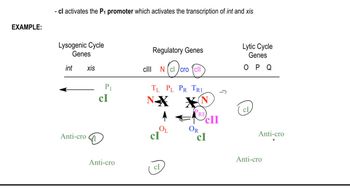Here are the essential concepts you must grasp in order to answer the question correctly.
Lytic and Lysogenic Cycles
The lytic and lysogenic cycles are two distinct pathways that bacteriophages, like λ phage, can follow after infecting a host bacterium. In the lytic cycle, the phage replicates rapidly, leading to the destruction of the host cell and the release of new phage particles. In contrast, the lysogenic cycle involves the integration of the phage DNA into the host genome, allowing it to replicate along with the host cell without causing immediate harm.
Recommended video:
Decision Between Lytic and Lysogenic Cycles
Gene Function in Phage Life Cycles
Specific genes in λ phage are crucial for determining whether the phage enters the lytic or lysogenic cycle. For instance, genes that regulate the expression of proteins involved in the decision-making process, such as the cI repressor, play a significant role. Mutations that inactivate these genes can disrupt the balance between the two cycles, potentially favoring one pathway over the other.
Recommended video:
Mutations and Their Effects
Mutations are changes in the DNA sequence that can affect gene function. In the context of λ phage, mutations that inactivate genes essential for the lytic or lysogenic cycles can lead to altered phage behavior. For example, a mutation that inactivates a gene responsible for lysogeny may force the phage to enter the lytic cycle, resulting in increased viral replication and host cell lysis.
Recommended video:
 Verified step by step guidance
Verified step by step guidance Verified video answer for a similar problem:
Verified video answer for a similar problem:



 4:29m
4:29m